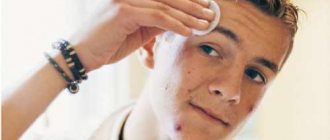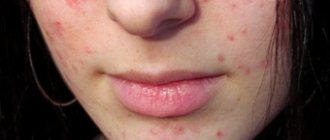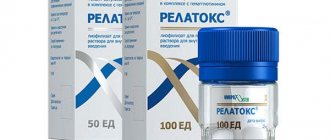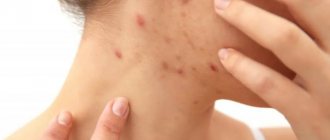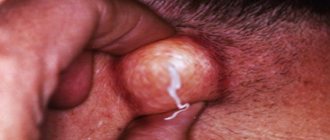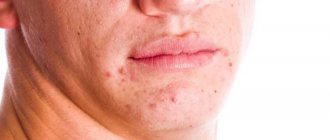Causes of acne in children and adolescents
Pimples occur when pores become clogged. What type of acne occurs depends on what is clogging the pores. Although scientists are still trying to figure out why some people's skin is more prone to developing acne, it's likely that hormones play a role. This explains why acne is so common among teenagers.
During puberty, hormones called androgens increase the size of the skin's oil glands. These glands begin to produce more sebum, which can clog your pores.
But acne can start before (or after) adolescence. About 20% of newborns suffer from neonatal acne, which usually appears between the second and fourth weeks of life. This type of acne goes away on its own without leaving any scars. It also does not increase the risk of developing severe acne later in life.
Some children develop infantile acne, which appears between 3 and 6 months of age. Baby acne can cause deep nodules and cysts, leading to permanent acne scarring. Fortunately, childhood acne is rare. Source: Modern concept of the etiopathogenesis of acne vulgaris. Isaeva M.S., Burieva Z.T. Avicenna Bulletin, 2010. p. 127-132 Pathogenetic approaches to the treatment of acne vulgaris. Khaldin A.A., Mareeva E.B., Skvortsova A.I. Russian Journal of Skin and Venereal Diseases, 2012. p. 34-37.
What causes acne and what causes it
While stress may not cause acne, it can make existing acne worse. Research shows that when stress increases, the severity of acne increases. Acne may get worse if teens:
- sleep too little;
- eat certain foods traditional to the Western diet;
- use oily cosmetics and skin care products.
Almost everyone experiences at least a few breakouts during their teenage years. It is impossible to predict who will develop more severe acne, but there is an increased risk if one or both parents (or other close blood relatives) have had severe acne that results in scarring.
“La-Cri” products and their help in the treatment of allergies on the cheeks of a child
Upon completion of the main stage of therapy, you should focus on eliminating the most unpleasant external symptoms. La-Cri cosmetics can help you with this:
- La-Cri cream relieves itching and redness, soothes irritation;
- Emulsion "La-Cri" moisturizes and nourishes dry skin, reduces sensitivity;
- Cleansing gel "La-Cri" gently cleanses the skin and helps reduce the degree of negative environmental impact.
These products contain plant extracts, safe oils, panthenol, bisabolol and other useful components. At the same time, La-Cri creams, gel and emulsion do not contain parabens, fragrances or hormones, so they can be used even for the smallest children with sensitive skin.
Types of acne, formation mechanism and what they look like
Teenage acne on the face of adolescents can be of several types (or a combination of them). Source: Pathogenetic rationale for local acne therapy in adolescence. Mazitova L.P., Aslamazyan L.K., Kvachakhiya L.L., Namazova L.S. Pediatric pharmacology, 2008. pp. 94-97):
- whiteheads;
- black dots;
- acne;
- nodules, cysts, or both (deep and painful).
- Whiteheads . Removing whiteheads can lead to more whiteheads and acne scars, which is why dermatologists recommend treating whiteheads with an acne treatment rather than picking at them. Whiteheads form when excess oil and dead skin cells clog the pores. This causes white or flesh-colored pimples to appear. Medical name: closed comedon, which means “closed pore.”
- Black dots . Dermatologists recommend treating this type of acne with a retinoid, since squeezing the blackheads can cause infection or permanent scarring. This type of acne also develops when excess sebum and dead skin cells accumulate inside the pore. As the secretion accumulates, it expands the pores and you see blackheads. Many people mistakenly believe that a black spot is dirt. What you are actually seeing is a chemical reaction. When deposits inside the pore react with oxygen in the air, a black color appears. Medical name: open comedo, which means “open pore.”
- Sometimes excess oil, dead skin cells and bacteria get trapped in the pores. Bacteria, which are usually found on our skin, can multiply quickly in excess oil. As the pores become filled with bacteria, inflammation (swelling) develops and a pimple appears. Medical name: If a pimple contains pus, it is called a pustule . A pimple without pus is called a papule .
- Nodule or cyst . When the pores become filled with excess oil, dead skin cells and bacteria, causing inflammation (swelling) that penetrates deep into the skin, a lump or cyst forms. Because these rashes penetrate deep into the skin, they can be painful. The main difference between a nodule and a cyst is that the cyst contains pus. Because nodules do not contain pus, they feel firmer to the touch than cysts.
Allergy on the cheeks of a child: how to treat it, besides traditional medicine?
Treating cheek allergies in a one-year-old child using traditional recipes is a risky idea. During this period, you can use only external remedies - lotions, compresses and baths with the addition of decoctions of string, violet, and oak bark.
In any case, before starting to use traditional medicine recipes, do not forget to consult a pediatrician or allergist.
Consequences of acne
Acne can cause more than just rashes. Some people believe that acne is a skin condition that eventually outgrows, but it can have a profound and lasting impact on one's life. Many people experience one or more of the following after acne appears.
Acne scars: When the breakout goes away, it leaves behind a permanent scar. Some scars cause indentations in the skin. The rest are gradually disappearing. It's impossible to predict who will develop scars after their acne goes away, but the following factors increase your risk:
- acne has been present for a long time because the teenager does not treat it or the treatment does not work;
- One or more close blood relatives have had acne in the family.
Dark spots on the skin: As acne breakouts fade, some people see the area where acne once was. This completely flat spot can be pink, red, purple, black or brown, and is often mistaken for a permanent acne scar. Source: Modern Treatments and Rehabilitation of Acne Vulgaris. Barinova A.N. Russian family doctor, 2022. p. 5-18.
Diagnostics
If your teen has acne, a dermatologist can diagnose acne by looking at the breakouts. During your appointment, your dermatologist will also note what types of acne they are and where the breakouts appear on the skin. This will help your dermatologist create an effective treatment plan. Sometimes what looks like pimples is another problem. For example, some people mistake hidradenitis suppurativa, also called acneinversa, for everyday acne. Treatment for this condition is different from that for acne. Another disease that can be mistaken for acne is perioral dermatitis. This often causes rashes that look like pimples around the mouth. Whether your teen has stubborn acne or another condition, a dermatologist can accurately diagnose acne vulgaris and create a treatment plan tailored to your teen's needs.
Treatment of facial acne in teenagers
The appropriate acne treatment plan depends on many factors, including:
- type of acne;
- where acne appears on the skin;
- what treatments have already been tried;
- when the rash started;
- age;
- whether acne left dark spots or scars Source: Modern methods of treating acne in children. Nosacheva O.A., Torshkhoeva R.M., Namazova-Baranova L.S. Pediatric pharmacology, 2013. p. 23-30.
Your treatment plan may vary. But there are a number of drugs that are included in clinical guidelines for the treatment of acne. Effective treatment for facial acne in a teen may include retinoid medications, benzoyl peroxide, azelaic acid, or salicylic acid. An antibiotic may be prescribed and applied to the skin.
Nodules and cysts are more difficult to treat. Treatment may consist of prescription medications applied to the skin, antibiotics, and isotretinoin (a medication approved for the treatment of severe acne).
Sometimes additional laser or light therapy is needed: Research shows that laser and light devices can help clear up acne. This type of treatment works best in combination with other acne treatments.
Healthy Diet: Some studies show that eating a healthy diet can also help give you clearer skin.
Skin care is so important that without it you won't get the results you want. Even if you use an acne treatment correctly, if teens are too rough on their skin, new breakouts may appearSource: Combination Acne Therapy. Mamarasulov D.I., Yuldashev M.A., Moon A.V., Ismoilov B.B. Medicine: theory and practice, 2019. p. 342-343.
Treatment for cheek allergies
The choice of treatment tactics depends entirely on what caused the allergic reaction. Finding and eliminating this cause should be the first step towards healing. This may require diagnostic methods such as blood tests, provocative tests, and patch tests.
Most often, if allergic reactions occur, it is recommended to switch to a hypoallergenic diet and, if possible, abandon medications; however, the decision on the amount of therapy must be made by the physician. If the child suffers from severe itching, the doctor may prescribe antihistamines and antipruritic drugs. If there are rashes or weeping erosions, the use of corticosteroid ointments and creams may be required.
Prevention
Do not wash your face with soap or use rough scrubs too often. Acne is not caused by dirt. Two gentle washes a day are enough. Exfoliating your skin too often can cause irritation and dryness of the skin, which causes the glands to produce more oil, which increases the likelihood of acne.
Use non-comedogenic products (those that do not clog pores) on your face.
Do not press on the spots, as this can drive bacteria deeper into the skin. This can lead to more inflammation and permanent scarring.
Sources:
- Modern concept of etiopathogenesis of acne vulgaris. Isaeva M.S., Burieva Z.T. Avicenna Bulletin, 2010. p. 127-132
- Pathogenetic approaches to the treatment of acne vulgaris. Khaldin A.A., Mareeva E.B., Skvortsova A.I. Russian Journal of Skin and Venereal Diseases, 2012. p. 34-37
- Modern methods of treatment and rehabilitation of patients with acne vulgaris. Barinova A.N. Russian family doctor, 2022. p. 5-18
- Pathogenetic rationale for local therapy for acne in adolescence. Mazitova L.P., Aslamazyan L.K., Kvachakhiya L.L., Namazova L.S. Pediatric pharmacology, 2008. p. 94-97
- Modern methods of treating acne in children. Nosacheva O.A., Torshkhoeva R.M., Namazova-Baranova L.S. Pediatric pharmacology, 2013. p. 23-30
- Combination therapy for acne. Mamarasulov D.I., Yuldashev M.A., Moon A.V., Ismoilov B.B. Medicine: theory and practice, 2022. p. 342-343
The information in this article is provided for reference purposes and does not replace advice from a qualified professional. Don't self-medicate! At the first signs of illness, you should consult a doctor.
What procedures cannot be performed at home if you have acne* on your nose?
Steaming, scrubbing, and mechanical cleaning are the most common and quite dangerous scheme for fighting acne at home. If there are foci of inflammation on the skin, such manipulations only aggravate the situation. And here's why106:
- Local heating promotes the active proliferation of bacteria, causes pathogenic activity of the sebaceous glands, which in turn leads to an expansion of the acne area and causes additional inflammation.
- Using a scrub in the presence of foci of inflammation will only aggravate the problem and expand the affected area. Abrasive particles injure the skin. Scrubbing can only be done when acne is in remission.
- Home manual cleansing is a taboo for acne-affected skin. This procedure can be performed only in the absence of inflammatory elements and preferably in a cosmetologist’s office. Independent attempts to carry out deep cleaning can aggravate the problem, lead to the formation of large pores, the appearance of scars and age spots (post-acne).
It is better to consult a dermatologist or cosmetologist about home treatments. The specialist will prescribe the necessary course of treatment and help you choose the right cosmetics to care for problem skin.
Prices
| Name of service (price list incomplete) | Price |
| Appointment (examination, consultation) with a dermatovenerologist, primary, therapeutic and diagnostic, outpatient | 1950 rub. |
| Consultation (interpretation) with analyzes from third parties | 2250 rub. |
| Prescription of treatment regimen (for up to 1 month) | 1800 rub. |
| Prescription of treatment regimen (for a period of 1 month) | 2700 rub. |
| Consultation with a candidate of medical sciences | 2500 rub. |
| Dermatoscopy 1 element | 700 rub. |
| Setting up functional tests | 190 rub. |
| Excision/removal of cutaneous/subcutaneous elements and formations (1 element) | 2550 rub. |
| Removal of milia of one unit using electrocoagulation | 350 rub. |

